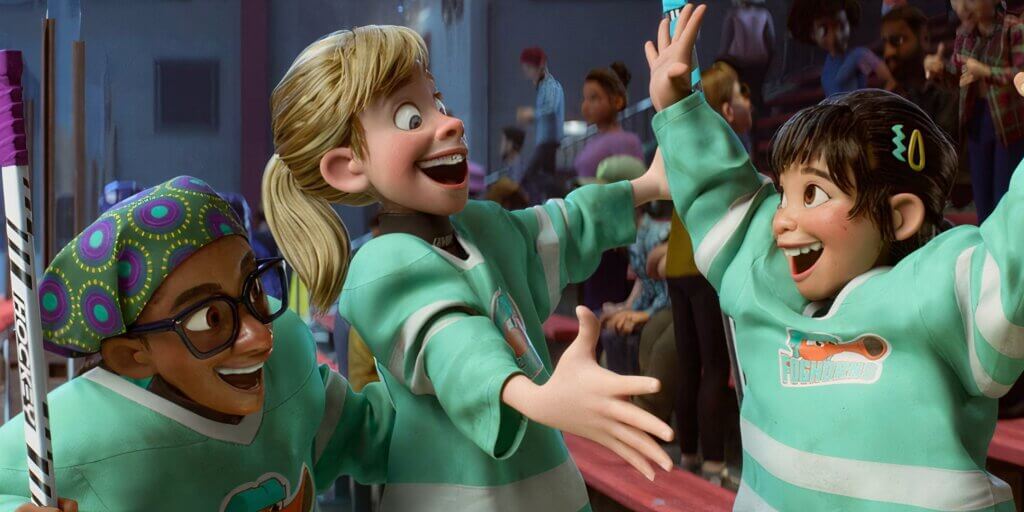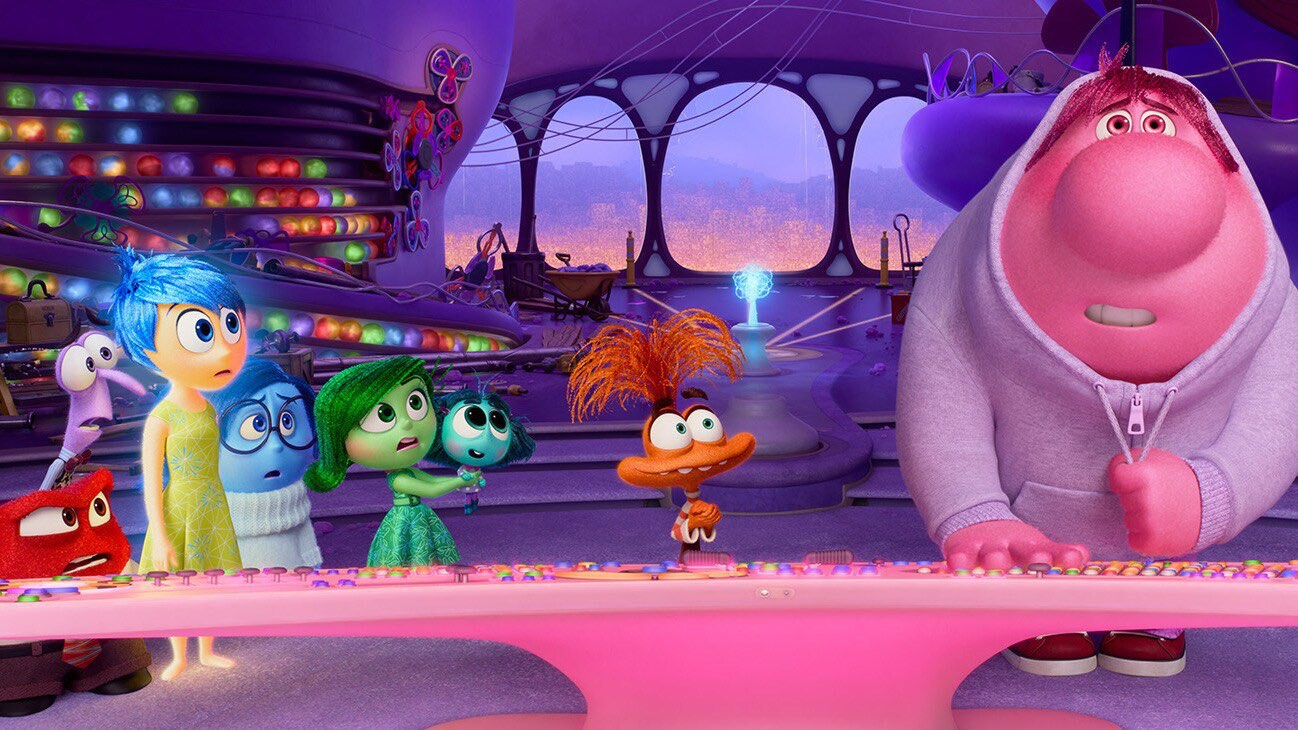What is Inside Out 2 about?
Inside Out 2 doesn’t stray too far from the formula of the original movie. But it manages to build on previous lessons. Inside Out focused on accepting emotions as they come. The sequel extends the conversation to the role past and future play in our sense of self and overall mental health. If you only focus on the present, it can cost you in the future. If you only focus on the future, you can make too many short-term sacrifices. The past grounds us. The future focuses us. And the present is to be enjoyed. Also, puberty is chaos.
Cast
- Joy – Amy Poehler
- Sadness – Phyllis Smith
- Anger – Lewis Black
- Disgust – Liza Lapira
- Fear – Tony Hale
- Anxiety – Maya Hawke
- Envy – Ayo Edebiri
- Ennui – Adèle Exarchopoulos
- Embarrassment – Paul Walter Hauser
- Riley – Kensington Tallman
- Riley’s mom – Diane Lane
- Riley’s dad – Kyle Maclachlan
- Grace – Grace Lu
- Bree – Sumayyah Nuriddin-Green
- Val – Lilimar
- Coach Roberts – Yvette Nicole Brown
- Lance Slashblade – Yong Yea
- Written by – Meg LeFauve | Dave Holstein
- Directed by – Kalsey Mann
“We don’t get to choose who Riley is.”
For much of Inside Out 2, Joy doesn’t realize she’s just as bad as Anxiety. When she finally makes it back to the front of the mind and sees the panic attack, she heroically tells Anxiety “You don’t get to choose who Riley is. You have to let her go.” A few moments later, Anxiety’s the one telling Joy, “You’re right, we don’t get to choose who Riley is.”
Joy had been, up to that point, unaware of how much she was curating Riley’s sense of self. She immediately flashes back to when she had led the nightly pruning of “bad” memories to send to the recesses of the mind. Joy’s own words echo: “We keep the best and toss the rest.”
All those memories Joy had deemed as not good enough were actually important, even if they weren’t positive, because they were educational. If you never remember the negative experiences, it’s difficult to reinforce the positive ones. It’s also impossible to develop a coping mechanism for when things actually go wrong—hence the panic attack. Riley’s newly formed Sense of Self synthesizes good and bad and allows her to self-stabilize.
Joy had been true to her nature—focused on the positive. We saw this in the first movie when she kept trying to relegate Sadness, thinking sadness was bad. But the major breakthrough there was that sadness can be a good thing. By showing sadness, you allow the people who love you to take care of you. And you grow closer to them because of it. In that way, sadness can lead to joy.
The filmmakers actually visually reinforced that relationship between Joy and Sadness. Disgust is all green. Fear is all purple. Anger is all red. Sadness is all blue. Joy is yellow with blue hair. Inside Out’s director, Pete Docter, said, of the blue hair, that “we liked the idea that even though she doesn’t understand sadness, she has an element of that in her right from the beginning.”
The same thing happens in Inside Out 2. Despite learning to let Riley feel different emotions in the moment, Joy had yet to understood how that applied in the long-term. Which is Anxiety’s major mission—long-term planning.
Ultimately, that’s the major shift between the two films. The first is concerned with emotion moment by moment, while the second puts emotion into the context of past and future. Joy, once again, has to broaden her one-dimensional view of what’s best for Riley and cede a little more control and power so the others can play a bigger role. Most importantly, Joy learns to trust Riley rather than curate an idea of Riley.
And that trust means that Riley isn’t always perfect. Compare the narration over the opening montage to the final one.
Joy, at the beginning: Riley is still exceptional. And not just because she’s at the top of her class, which, by the way, she is. She’s also really kind. And she’s nice to stray cats—I mean, c’mon! Oh, and she’s officially a teenager, now. She got very tall, very fast. We even got braces with extra rubber bands! Riley’s personality islands are still going strong.
At the end: She’s super smart. And great at hockey. She’s really creative. She can be bored but never boring. But, she can be a little sarcastic from time to time. She can have really bad ideas. Occasionally, she can do the wrong thing. Sometimes, she can be too hard on herself. But every bit of Riley makes her who she is. And we love all of our girl. Every messy, beautiful piece of her.
The first is only positive and Joy says everything. While the second is realistic, acknowledges both the good and the bad, and the other emotions have the opportunity to narrate. So everything adds up to appreciating this more holistic self. “I’m a good person but not a perfect person and that’s okay.”
Take your time
Due to Anxiety, Riley becomes obsessed with making the high school hockey team. It becomes a now-or-never situation for her. Even though she’s just going to be a freshman and has plenty of hockey ahead. Anxiety’s desperation doesn’t allow Riley to put things into perspective and simply enjoy the moment. It isn’t until Riley finally manifests her new sense of self that hockey camp becomes joyful rather than stressful. The formal aspects of the film reflect Riley’s happiness. Shots of her skating. Puck handling. Smiling. Passing to others. It’s no longer about her future but, once again, being present and cherishing the present to the best of your ability.
The main dialogue supporting this happens at the very end. After lunch, Val says, “If you don’t make it this year, there’s always next year.” And, Riley, content with whatever happens, says, “I know.” That causes Anxiety to say “I love our girl.” Which is the film reinforcing Riley’s answer was the correct one.
What we imagine matters
The climax of Anxiety’s time as captain of the ship is Riley’s negative sense of self—I’m not good enough. When the emotions first hear the statement, especially Anxiety, it shocks them. Saddens them. They all love Riley. So the idea they made her think she wasn’t good enough…that hurts. Which is why Anxiety becomes so desperate—she thinks if she can score three goals that Riley will be good enough.
One of the big contributing factors to Riley’s negative self-esteem is the fact Anxiety keeps asking Imagination Land to conceive of worst case scenarios. A parade of disastrous situations plays through Riley’s mind. In each one, she’s at fault. While this doesn’t lead to a panic attack, we see how she can’t sleep and it kicks off the accumulation of a really toxic energy that eventually turns into the panic attack.
How do the first generation emotions save they day? They have Riley’s imagination come up with positive scenarios. This kind of positive reinforcement provides Riley with enough comfort and confidence that she can fall asleep.
In reality, sports science supports the effect of imagination on well-being and performance. Famously, Michael Phelps, the greatest Olympic swimmer of all-time, used visualization every night before going to bed as well as prior to races.
From Swimming World Magazine: Phelps would rehearse his races hundreds of times before the day of the race so that when he would step up on the blocks, his body goes on autopilot. His body knew what to do from rehearsing so many times, and his races became second nature in a way that his brain already knew how to swim the race. One important part of Phelps’ visualization was imagining anything that could go wrong and being prepared for it. If he had a suit rip or goggles fill up with water, he would be ready to fix the issue or overcome the adversity of swimming with water in his goggles. That way, once race day came and for some reason one of those things happened, his mind did not go into panic mode. Phelps was able to stay calm and work out the problem.
Notice that Phelps did imagine what could go wrong. But it definitely wasn’t in the anxiety-driven way that Riley goes about it. What Anxiety wanted to do was good, but the how was problematic.
What was Riley’s deep, dark secret?
We see the Deep Dark Secret locked in the vault. Despite Joy and the others wanting to know the secret, Deep Dark won’t tell. And then the movie keeps going and we kind of forget about it. But there’s a stinger after the credits that reveals…Riley once burned a hole in the rug. That’s it.


